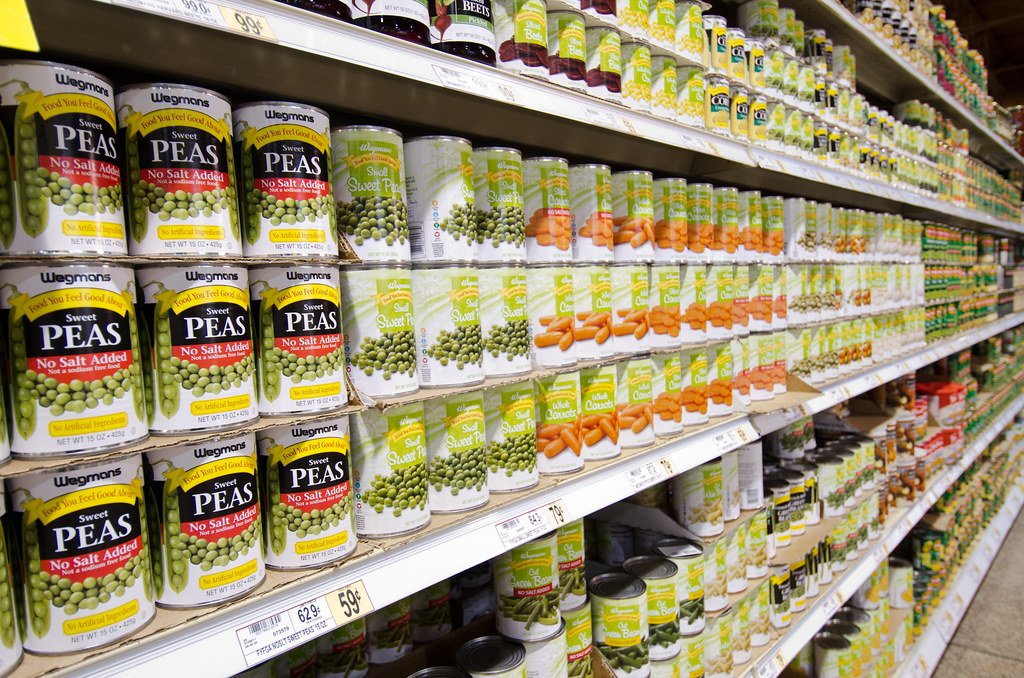You know that satisfying feeling of triumph when you accomplish a big grocery haul, fully stocked with an assortment of canned goods that could feed an army? But hold on a moment…have you ever wondered how to properly store these precious cans so they don’t end up lost in the depths of your pantry or worse, spoil before you can indulge in their delectable contents? Fear not, for we come bearing essential tips to ensure your canned treasures are stored in the most organized and efficient manner, guaranteeing a taste of perfection every time you crack one open. So, roll up your sleeves, grab your cans, and let us unveil the secrets to preserving your canned culinary delights with finesse.
Table of Contents
- Organizing Your Canned Goods: A Guide to Optimal Storage
- Understanding Shelf Life: How Long Can Canned Goods Last?
- Temperature and Humidity: Ideal Storage Conditions for Your Canned Goods
- Preserving Quality: Best Practices for Storing Canned Goods
- Maximizing Shelf Space: Clever Tips for Efficient Canned Goods Storage
- Q&A
- Key Takeaways

Organizing Your Canned Goods: A Guide to Optimal Storage
Efficiently organizing your canned goods can bring a sense of order to your pantry and make meal preparation a breeze. With so many sizes, shapes, and types of canned goods available, finding the perfect storage solution can seem daunting. But fear not, we’ve got you covered! Follow these expert tips and tricks to keep your canned goods neatly arranged and easily accessible.
Sort and categorize
Begin by sorting your canned goods into categories. Group similar items together, such as vegetables, fruits, soups, and sauces. This step helps you identify and locate specific cans quickly, saving you time and effort. You can choose to use labeled baskets, bins, or shelves to separate each category.
Maximize your space
When it comes to organizing canned goods, using your pantry space efficiently is crucial. Utilize stackable can organizers or tiered shelves to make the most of vertical space. Stack cans of the same size together, creating stable towers, and avoid pyramid-like stacks that can cause cans to topple over. Additionally, consider using a rotating can rack for easy access to all your goods without having to shuffle items around.
Label and date
To prevent forgotten cans and avoid wastage, it’s essential to label and date your canned goods. Clearly mark the expiration dates on each can using a permanent marker or printable labels. By rotating your stockpile and placing the older cans in front, you can ensure that no can goes to waste.
With these expert tips, organizing your canned goods will no longer be a daunting task. Take the time to find a system that works best for you and enjoy the convenience of effortlessly locating your canned goods when preparing delicious meals.

Understanding Shelf Life: How Long Can Canned Goods Last?
When it comes to canned goods, we often find ourselves wondering just how long they can last in our pantries. With their convenience and ability to retain nutrients, canned goods have become a staple in many households. But what factors determine their shelf life?
First and foremost, the type of food in the can plays a vital role in determining its longevity. While canned fruits can last between 1-2 years, canned vegetables can typically remain fresh for 2-5 years. However, it is important to keep in mind that these timeframes are just general guidelines, and the actual shelf life may vary depending on various factors such as storage conditions and the specific brand.
Storage conditions have a significant impact on the shelf life of canned goods. It is crucial to keep them in a cool, dry place away from direct sunlight and extreme temperatures. Heat can cause the food inside the cans to spoil faster, while moisture can lead to rusting and potentially compromise the quality of the contents. Therefore, storing canned goods in a well-ventilated area with a consistent temperature is highly recommended.

Temperature and Humidity: Ideal Storage Conditions for Your Canned Goods
When it comes to preserving the quality and longevity of your canned goods, paying attention to the storage conditions is key. Maintaining the right temperature and humidity levels ensures that your canned goods remain safe to consume and retain their flavors for months or even years.
Temperature: It is crucial to store your canned goods in a cool and dry place. Ideally, temperatures should be below 85°F (29°C) to prevent spoilage. Heat can cause the food inside the cans to expand, potentially leading to a loss of quality or, in worst-case scenarios, bacterial growth. Avoid storing canned goods near heat sources such as stoves, ovens, or direct sunlight.
Humidity: While canned goods are not as vulnerable to humidity as some other food items, excessive moisture can still have detrimental effects. High humidity may lead to rusting and deterioration of cans, compromising the integrity of the food inside. Aim for humidity levels around 50-70% to prevent any moisture-related issues.
By following these guidelines, you can ensure that your canned goods remain in optimal condition, ready to be enjoyed whenever you need them. Remember to regularly check for any signs of damage, such as bulging or leaking cans, and discard them immediately for safety reasons. Proper storage not only safeguards your canned goods but also helps you maintain a well-stocked pantry for any culinary adventure that awaits.

Preserving Quality: Best Practices for Storing Canned Goods
Canned goods are an essential pantry staple, providing convenience and long-lasting nutrition. To ensure the longevity and quality of your canned goods, here are some best practices for storing them:
- Keep it cool: Store your canned goods in a cool, dry place, away from direct sunlight or sources of heat. Excessive heat can compromise the quality and safety of the contents.
- Rotate your stock: Practice the “first in, first out” method to prevent spoilage. When restocking your pantry, place the newer cans behind the older ones to ensure the oldest cans are used first.
- Check for damage: Before storing your canned goods, inspect them for any signs of damage, such as dents, bulges, or leaks. Damaged cans should be discarded as they may indicate bacterial growth or compromised seals.
Remember, proper storage not only maintains the quality and taste of your canned goods but also ensures their safety. By following these best practices, you can enjoy the deliciousness of your canned veggies, fruits, and soups for months to come!
Maximizing Shelf Space: Clever Tips for Efficient Canned Goods Storage
When it comes to organizing your pantry, efficient canned goods storage can make all the difference in maximizing shelf space. These clever tips will help you optimize your pantry and keep your canned goods neatly arranged for effortless access.
1. Use tiered organizers: Utilize tiered organizers to create multiple levels of storage within your pantry shelves. These space-saving wonders allow you to see and access all your canned goods at a glance without digging through cluttered stacks.
2. Implement a labeling system: Labeling your canned goods not only gives your pantry a streamlined look, but it also makes it easier to find specific items. Invest in a labeling machine or simply use printable labels to categorize your canned goods. This way, you can quickly locate what you need without disrupting the organization of your pantry.
3. Stack strategically: Stack your canned goods strategically to maximize shelf space. Place larger, bulkier cans at the back and smaller ones in front. By staggering the heights of your canned goods, you can make use of every inch of shelf space available.
With these clever tips, you can transform your pantry into an organized haven, making the most out of your available shelf space. Say goodbye to messy shelves and hello to efficient canned goods storage!
Q&A
Why is properly storing canned goods important?
Storing canned goods properly is important to ensure their longevity and maintain their quality. It helps prevent spoilage, preserve nutritional value, and avoid harmful bacteria growth.
What is the best location to store canned goods in?
The best location to store canned goods is in a cool, dry place, away from direct sunlight and heat sources. A pantry or cupboard is ideal, as long as it is ventilated and maintains a consistent temperature.
Do canned goods have an expiration date?
Yes, canned goods usually have an expiration date stamped on the can. It is important to check the date and consume them before it expires to ensure freshness and safety.
Can I store canned goods in the refrigerator?
While it is not necessary to store canned goods in the refrigerator, it is perfectly safe to do so once the can is open. Transferring leftovers to a covered container is advisable to maintain flavor and prevent odor transfer.
Should I rotate canned goods in my pantry?
Yes, rotating canned goods in your pantry is recommended. By practicing the principle of “first in, first out,” you can use the oldest cans first and ensure that none go past their expiration date.
What types of canned goods do not require refrigeration after opening?
Most canned goods, like fruits, vegetables, and soups, do not require refrigeration after opening. However, it’s always good to check the label for specific instructions, especially for products containing meat or dairy.
How can I tell if a canned good is spoiled?
If a canned good appears swollen, dented, leaking, or emits an unusual odor, it may be spoiled and should not be consumed. Additionally, any visible mold growth or significant changes in texture or color are signs of spoilage.
Key Takeaways
From pantry organization to a world of culinary possibilities, storing canned goods takes us on a transformative journey. With these essential tips, embracing the art of preservation becomes a joyous and efficient experience.
As we bid farewell to our exploration of canned goods storage, we leave you equipped with the knowledge to maintain both order and flavor in your pantry. By creating a system that marries practicality with creativity, your canned treasures will unveil themselves effortlessly.
Remember, the first rule in this thrilling endeavor is to bestow your cans with the crown they deserve – a cool, dark haven, protected from the clamor of sunlight and heat. For optimal flavor preservation, employ a rotational system, ensuring older cans take precedence while the young ones patiently wait their turn.
But don’t let your creativity be limited to mere organization! Immerse yourself in the poetic dance between the ingredients in your pantry. Allow the symphony of flavors to unfold with harmonic freshness: let sweet corn harmonize with tangy tomatoes, and delicate mushrooms blend seamlessly with hearty beans. Discover the true mastery of culinary alchemy, where from tinned treasures springs forth an extraordinary feast.
These tips are your backstage pass to the enchanting world of endless possibilities, where a humble can becomes your gateway to gastronomic bliss. Whether you embrace Mexican flavors, Mediterranean wonders, or Asian symphonies, rest assured that your pantry is prepared to escort you on a voyage of unparalleled tastes.
So, dear explorers of the caniverse, armed with knowledge, organization, and a pinch of culinary audacity, let us venture forth into a world brimming with delicious potentials. As we close the cabinet doors on this article, may your pantry overflow with inspiration and tantalizing ingredients, ever ready to transform the mundane into extraordinary delights.
Bon appétit, benevolent collectors of canned goods, and may every dish that graces your table be a testament to the artistry of preservation. Until our paths cross again, may the cans be forever in your favor.
As an affiliate, my content may feature links to products I personally use and recommend. By taking action, like subscribing or making a purchase, you’ll be supporting my work and fueling my taco cravings at the same time. Win-win, right?
Want to read more? Check out our Affiliate Disclosure page.